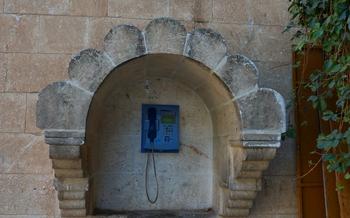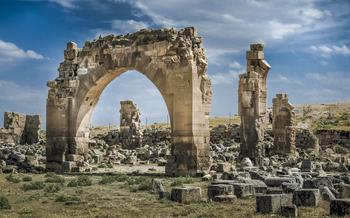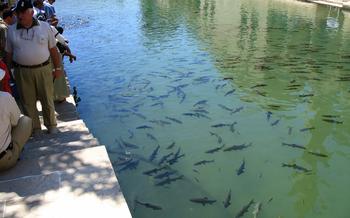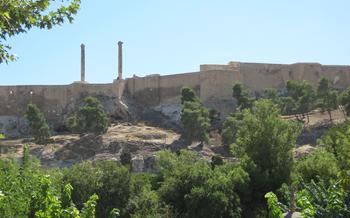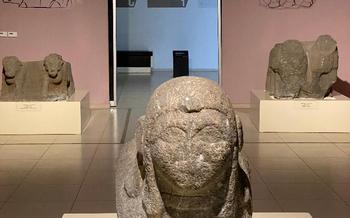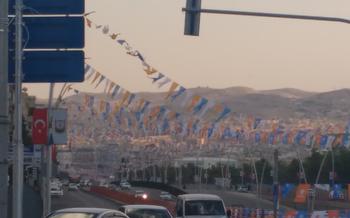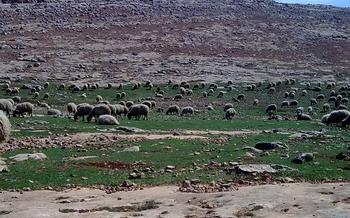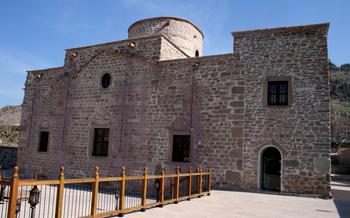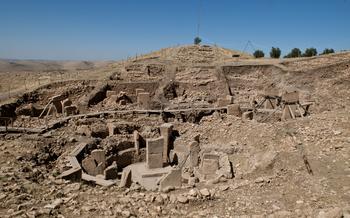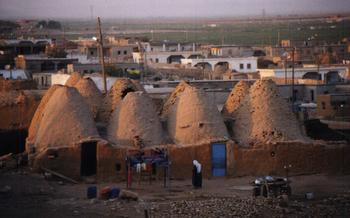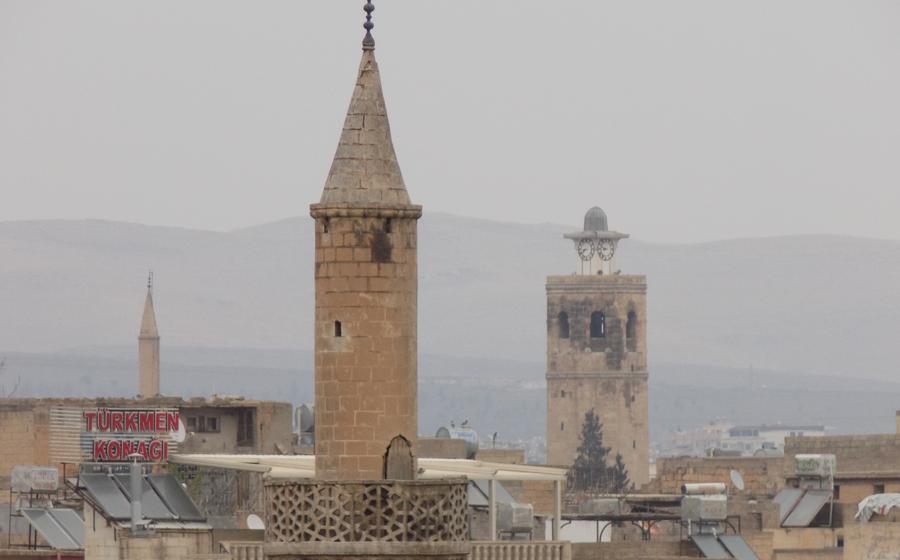
Mençek Cave
- The Antiquity of Mençek Cave
- Mençek Cave's Natural Formations
- Exploring the Cave's Chambers
- Carvings and Artifacts
- Mençek Cave's Legendary Past
- Religious Significance of the Cave
- Visiting the Mençek Cave
- Planning Your Trip
- Mençek Cave Museum: Preserving the Past for Future Generations
- Exploring the Surrounding Area
- Mençek Cave's Contribution to Paleontology
- Conservation Efforts
- The Cave's Role in Tourism
- Educational Opportunities
- Insider Tip
The Antiquity of Mençek Cave
Mençek Cave, nestled in the heart of Şanlıurfa, Turkey, holds a profound historical significance that dates back to the dawn of civilization. Its ancient origins have been meticulously studied by archaeologists and historians, revealing a captivating tale of human habitation and cultural evolution.
During excavations conducted within the cave, numerous artifacts and remnants of past civilizations have been unearthed, providing glimpses into the lives of those who once sought shelter and refuge within its walls. These discoveries, ranging from intricate tools to remnants of daily life, have shed light on the cave's role as a sanctuary for prehistoric communities.
Beyond its archaeological importance, Mençek Cave also holds deep religious and cultural significance. Ancient inscriptions and symbols adorning the cave's walls suggest that it was once a sacred site, revered by various religious groups throughout history. These markings, often depicting religious figures or symbols, offer a glimpse into the spiritual beliefs and practices of past civilizations.
Mençek Cave's Natural Formations
The Mençek Cave is renowned for its awe-inspiring natural formations that have been shaped over millions of years by geological processes. The cave's walls, ceilings, and floors are adorned with intricate and unique rock formations, including stalactites and stalagmites. Stalactites, which hang from the ceiling, and stalagmites, which rise from the floor, are formed by the deposition of minerals from water seeping through the cave's limestone bedrock. Over time, these formations have grown into mesmerizing shapes and sizes, creating a surreal and captivating underground landscape.
The cave's geological history is a fascinating one. The region where the cave is located was once covered by a shallow sea. Over time, the sea receded, and the limestone that formed the seabed was exposed to the elements. Rainwater seeped into the limestone, dissolving it and creating underground cavities. These cavities gradually expanded, forming the cave system we see today.
The Mençek Cave is home to a diverse array of stalactites and stalagmites, each with its own unique shape and character. Some resemble delicate icicles, while others have grown into massive columns and pillars. The cave's walls are adorned with intricate patterns and textures, created by the flow of water and the deposition of minerals. The interplay of light and shadow on these formations creates a magical and ethereal atmosphere, making the Mençek Cave a truly unforgettable sight to behold.
Exploring the Cave's Chambers
The Mençek Cave is a vast and intricate labyrinth of chambers, each with its own unique features and characteristics. The main chamber, known as the Grand Hall, is awe-inspiring in its size and grandeur. Its high ceiling and expansive walls are adorned with intricate stalactites and stalagmites, creating an otherworldly ambiance.
As you venture deeper into the cave, you'll encounter a series of smaller chambers, each with its own distinct charm. The Crystal Chamber, for example, is home to an array of sparkling calcite crystals that shimmer and reflect light, creating a magical and ethereal atmosphere. Another chamber, known as the Hidden Chamber, is accessible through a narrow and winding passageway. Once inside, you'll discover a secluded and intimate space adorned with delicate formations and ancient inscriptions.
Navigating the cave's chambers can be a challenging but rewarding experience. It's highly recommended to explore the cave with a knowledgeable guide who can lead you safely through the intricate passages and provide insights into the cave's history and geology. With their expertise, you'll be able to discover hidden corners and secret chambers that might otherwise go unnoticed.
Carvings and Artifacts
Mençek Cave is not only a natural wonder but also a treasure trove of ancient inscriptions and artifacts that offer glimpses into the lives and beliefs of past civilizations. The walls of the cave are adorned with enigmatic symbols and carvings, some of which date back to the Neolithic period. These symbols, often featuring animals, humans, and geometric patterns, provide clues about the cave's religious and cultural significance.
Archaeologists have also discovered a variety of artifacts within the cave, including pottery shards, tools, weapons, and jewelry. These finds suggest that the cave was once inhabited or used for ceremonial purposes by prehistoric people. The discovery of human remains and burial goods further supports the theory that the cave held spiritual importance for ancient communities.
The artifacts and carvings found in Mençek Cave offer valuable insights into the cultural and artistic traditions of the region's earliest inhabitants. They provide tangible evidence of the rich history and heritage of Şanlıurfa and contribute to our understanding of the development of human civilization in the area.
Mençek Cave's Legendary Past
The Mençek Cave is shrouded in a rich tapestry of myths and legends that have been passed down through generations, weaving a captivating narrative around its existence. Local folklore tells of a legendary creature known as the "Mençek," a mythical beast said to inhabit the cave's depths. According to tales, the Mençek is a protector of the cave, guarding its secrets and treasures. It is believed that those who show respect and seek the Mençek's blessing will be granted safe passage and good fortune within the cave.
Another legend speaks of a hidden chamber within the cave, known as the "Chamber of Treasures." It is said that this chamber contains vast riches and artifacts of unimaginable value, accumulated over centuries by the Mençek and other guardians of the cave. Many have sought to find this hidden chamber, but only those with pure intentions and a genuine connection to the cave are said to succeed.
These legends and stories have added to the mystique and allure of the Mençek Cave, captivating the imaginations of visitors and locals alike. They serve as a reminder of the rich cultural heritage and storytelling traditions that are deeply intertwined with the cave's history and significance.
Religious Significance of the Cave
The Mençek Cave holds religious significance for various faiths and cultures. Throughout history, it has served as a sacred site for rituals and ceremonies, attracting pilgrims from near and far. In ancient times, it was believed to be a place of worship for the goddess Cybele, the Anatolian mother goddess. Evidence of these rituals can still be seen in the cave, such as rock carvings and inscriptions dedicated to Cybele.
Later, during the Byzantine period, the cave became a Christian sanctuary. It is said that early Christians used the cave as a hiding place during times of persecution and conducted secret religious ceremonies within its chambers. There are still remnants of Christian iconography and symbols found in the cave, such as crosses and inscriptions in Greek.
In the Islamic tradition, the Mençek Cave is associated with the prophet Abraham. According to local folklore, Abraham passed through the region and rested in the cave during his journey. This connection has made the cave a pilgrimage site for Muslim visitors, who come to pay homage to the prophet and seek blessings.
Visiting the Mençek Cave
Tourist Facilities and Amenities:
Mençek Cave is well-equipped to accommodate tourists and provide a comfortable and informative experience. Visitors can find a range of facilities and amenities to enhance their exploration of the cave. These include:
-
Visitor Center: Located near the cave entrance, the visitor center offers a wealth of information about the cave's history, geology, and cultural significance. It features exhibits, maps, and educational displays that help visitors understand the unique features of Mençek Cave.
-
Guided Tours: Experienced and knowledgeable guides lead informative tours of the cave, providing insights into its formations, history, and legends. These tours are available in various languages and cater to different interests and levels of expertise.
-
Lighting and Safety Measures: The cave is well-lit to ensure visitors' safety and enhance their exploration. Pathways and walkways are designed to provide easy access and prevent accidents.
-
Accessibility: Mençek Cave is accessible to visitors of all abilities, including those with limited mobility. Ramps, handrails, and accessible pathways make it possible for everyone to enjoy the cave's wonders.
-
Souvenir Shop: A gift shop at the visitor center offers a range of souvenirs and memorabilia related to Mençek Cave. Visitors can purchase handcrafted items, books, postcards, and other keepsakes to remember their visit.
Planning Your Trip
Visiting Mençek Cave requires careful planning to ensure a smooth and enjoyable experience. The best time to visit the cave is during the spring or autumn months when the weather is pleasant, and the crowds are smaller. Pack comfortable and sturdy shoes for navigating the cave's uneven terrain. Consider bringing a flashlight or headlamp for exploring darker areas of the cave. Accommodation and dining options are available in nearby towns and villages, offering a range of choices to suit different budgets and preferences.
Mençek Cave Museum: Preserving the Past for Future Generations
The Mençek Cave Museum stands as a testament to the enduring significance of Mençek Cave. Established near the cave's entrance, this museum houses a wealth of artifacts, exhibits, and interactive displays that delve into the cave's rich history, cultural importance, and geological wonders. Visitors can embark on a journey through time, exploring the cave's ancient origins, discovering the stories of those who have journeyed within its depths, and gaining a deeper understanding of the natural processes that shaped its unique formations.
The museum's exhibits showcase a diverse array of artifacts unearthed from the cave, including ancient tools, pottery, and jewelry. These relics offer a tangible connection to the people who once inhabited or visited the cave, providing insights into their daily lives and cultural practices. Interactive displays bring the cave's geological formations to life, allowing visitors to witness the processes of stalactite and stalagmite formation and to explore the intricate network of chambers and tunnels that make up the cave system.
Through its exhibits and educational programs, the Mençek Cave Museum plays a vital role in preserving the cave's legacy and promoting its importance as a cultural and natural heritage site. The museum serves as a valuable resource for researchers, students, and visitors alike, fostering a deeper appreciation for the cave's unique features and its place in human history and scientific exploration.
Exploring the Surrounding Area
Beyond the allure of Mençek Cave itself, the surrounding region offers a treasure trove of attractions that beckon travelers to delve deeper into Turkey's rich history and natural wonders. A short distance away, visitors can marvel at the ancient ruins of Harran, once a thriving city that dates back to the Neolithic era. Its unique beehive-shaped houses, constructed from mud bricks and straw, provide a glimpse into the ingenuity of past civilizations.
History buffs can immerse themselves in the grandeur of Göbekli Tepe, an archaeological site that has revolutionized our understanding of human history. This enigmatic complex of megalithic structures, believed to be the world's oldest temple, predates Stonehenge by thousands of years and offers a glimpse into the religious and cultural practices of our ancestors.
Nature enthusiasts will find solace in the nearby Viranşehir Lake, a haven for birdwatchers and outdoor enthusiasts. This picturesque lake, teeming with diverse birdlife, provides an idyllic setting for tranquil walks, picnics, and birdwatching expeditions.
For a unique cultural experience, venture into the bustling markets of Şanlıurfa, where vibrant colors, enticing aromas, and the lively banter of vendors create a vibrant atmosphere. Here, visitors can bargain for traditional handicrafts, savor the flavors of local cuisine, and immerse themselves in the infectious energy of Turkish hospitality.
Mençek Cave's Contribution to Paleontology
Mençek Cave has proven to be a treasure trove for paleontologists, yielding a wealth of fossil discoveries that have shed light on the ancient flora and fauna that once inhabited the region. Among the most significant finds are fossilized remains of prehistoric animals, including mammoths, saber-toothed tigers, and giant hyenas. These discoveries provide valuable insights into the evolutionary history of these species and their adaptation to the changing environment.
Moreover, the cave has yielded a rich collection of plant fossils, including leaves, seeds, and pollen grains. These fossils offer a glimpse into the region's past climate and vegetation, allowing scientists to reconstruct the ancient ecosystem that existed in and around the cave. The presence of tropical and subtropical plant species suggests that the climate was once much warmer and more humid than it is today.
The paleontological significance of Mençek Cave has attracted researchers from around the world, who have conducted extensive excavations and studies to uncover its hidden secrets. Ongoing research continues to reveal new insights into the region's prehistoric past, making the cave an important site for paleontological research and exploration.
Conservation Efforts
The Mençek Cave is a precious natural and cultural heritage site that requires careful preservation to ensure its integrity for future generations. Conservation efforts are crucial to protect the cave's unique formations, fossils, and artifacts. Sustainable tourism practices are implemented to minimize the impact of tourism on the cave's environment. Guided tours are conducted responsibly, with a focus on educating visitors about the cave's significance and the importance of preserving its delicate ecosystem.
To protect the cave's natural formations, access to certain areas may be restricted, and strict regulations are in place to prevent vandalism and damage. Conservationists and researchers work together to monitor the cave's condition and implement conservation measures, such as stabilizing rock formations, controlling humidity and temperature levels, and preventing erosion.
Balancing tourism with preservation is a delicate task. The cave's popularity as a tourist destination has led to increased foot traffic, which can potentially damage the cave's fragile environment. Limiting the number of visitors and enforcing strict guidelines for tour operators helps to minimize the impact of tourism while still allowing people to experience the cave's wonders.
The Cave's Role in Tourism
Mençek Cave has become a significant attraction for domestic and international tourists, contributing positively to the region's economy. Its unique natural formations, historical significance, and cultural heritage have made it a must-visit destination. The influx of tourists has led to the development of tourism-related infrastructure, such as hotels, restaurants, and souvenir shops, providing employment opportunities and boosting the local economy.
Moreover, the cave's popularity as a tourist attraction has helped promote Şanlıurfa's cultural heritage and has positioned it as a prominent destination on the tourism map of Turkey. This has attracted visitors from around the world, who come to explore the cave's unique features and immerse themselves in the region's rich history and culture.
Supporting local businesses and communities is another vital aspect of the cave's tourism impact. Many local tour operators, guides, and artisans benefit from the increased tourist activity. The sale of traditional handicrafts, local delicacies, and souvenirs provides a source of income for local communities, fostering economic growth and preserving cultural traditions.
Educational Opportunities
The Mençek Cave offers a wealth of educational opportunities for visitors of all ages. Schools and educational institutions can organize field trips to the cave, where students can learn about geology, archaeology, paleontology, and cultural heritage firsthand. Workshops and seminars on cave exploration and conservation are also conducted regularly, providing participants with hands-on experience and in-depth knowledge. These educational initiatives not only promote scientific research and learning but also foster a greater appreciation for the cave's natural and cultural significance.
Insider Tip
-
Seek out a local guide who can provide insights and stories: Local guides often have a wealth of knowledge about the history, culture, and legends associated with the cave. They can share fascinating stories and anecdotes that bring the cave to life and make your visit more memorable.
-
Visit during off-peak hours to avoid crowds: Mençek Cave is a popular tourist destination, and it can get crowded during peak season. If you want to experience the cave in a more intimate and peaceful setting, try to visit during the off-season or on a weekday.
-
Bring sturdy shoes and a flashlight for cave exploration: The cave floor can be uneven and slippery, so it's important to wear sturdy shoes with good traction. A flashlight is also essential for exploring the cave's darker corners and passages.
